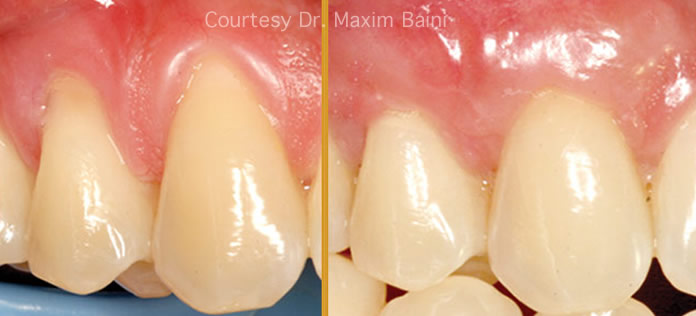Laser Gum Graft
Grafting is a procedure used to replace / restore missing bone or gum tissue. A gingival graft (also called gum graft or periodontal plastic surgery is a generic name for any of a number of surgical periodontal procedures whose combined aim is to cover an area of exposed tooth root surface with grafted oral tissue.
Long teeth/ Exposed roots:

At Ferrari Dental Clinics, Waterlase technology allows us to perform gum grafting procedures in minutes with virtually no bleeding of the operated site.
Laser Gum Graft:

Benefits of Laser gum graft:
- Faster healing.
- Minimal post-op discomfort.
- Less bleeding.
- Spend less time in the dental chair than traditional surgery.
- Reduced risk of infection.
- Decreased sensitivity.
In most cases, it is not necessary to take painful gum grafts from other parts of the mouth, like the palate. Precise Waterlase energy sterilizes the area, dramatically reducing postoperative discomfort and promoting faster healing.
Traditionnal gum graft surgery:
- A free gingival graft is a dental procedure where a layer of tissue is removed from the patient's palate or gently moved over from adjacent areas and then relocated to the site of gum recession. It is stitched into place and will serve to protect the exposed root as living tissue by providing a stable band of attached gingiva around the tooth. The donor site will heal without damage. This procedure is often used to increase the thickness of very thin gum tissue. The gingival graft procedure is highly predictable and results in a stable, healthy band of attached tissue around the tooth.
Free gingival graft:

- A subepithelial connective tissue graft takes tissue from under healthy gum tissue in the palate, which may be placed at the area of gum recession. This procedure has the advantage of excellent predictability of root coverage, as well as decreased pain at the palatal donor site compared to the free gingival graft. The subepithelial connective tissue graft is used to not only restore missing thick keratinized gum tissue, but also used to cover exposed roots of the teeth.
Connective tissue graft:

- An acellular dermal matrix (such as Alloderm) graft uses donated medically-processed human skin tissue as a source for the graft. The advantage of this procedure is no need for a palatal donor site, however some periodontists believe it may be less successful, while others believe it is equally successful as a subepithlial connective tissue graft.
- A lateral pedicle graft, or pedicle graft, takes tissue from the area immediately adjacent to the damaged gingiva. This is not always an option, as the constraint that there must be sufficient tissue immediately lateral to the area of interest is an onerous one. When this procedure is performed, the transplant tissue is cut away and rotated over the damaged area. This can place the donor area at risk of recession as well.
- Coronally and apically positioned flaps , although technically not grafting procedures, are other forms of a pedicle grafts in that gingival tissue is freed up and moved either apically or coronally. This requires adequate thickness and width of gingival tissue at the base of the recession defect.